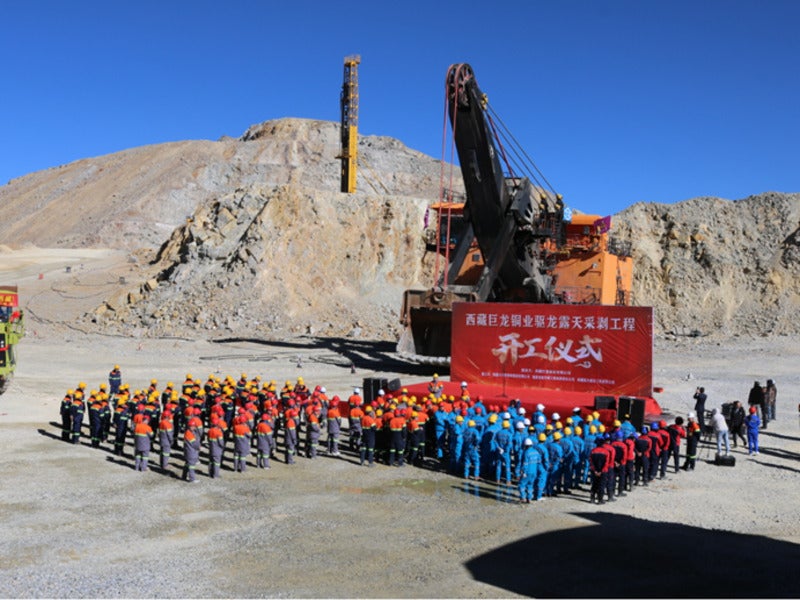The Qulong copper and polymetallic mine is an open-pit mining project under construction in the Tibet Autonomous Region (TAR) of China. Zijin Mining Group is the majority owner and the operator of the project.
Tibet Julong Copper, established in December 2006, was granted the mining rights for the Qulong, Rongmucuola, and the Zhibula copper polymetallic deposits in the region.
Tibet Zijin, a wholly-owned subsidiary of Zijin Mining, acquired an aggregate 50.1% equity interest in Tibet Julong Copper comprising Zhangge Venture Capital Group (12.88%), Zhongsheng Mining (18%), Zhangge Company (6.22%), Shenzhen Chenfang (10%) and Huibaihong Industrial (3%) in July 2020. Zhangge Company and Mozhugongka County retain the remaining 24.9% and 25% stakes in the project.
The Ministry of Land and Resources (MLR) of the People’s Republic of China (PRC) granted a mining permit for the Qulong copper mine in September 2016.
While the construction works on phase one of the Qulong mining project were started in September 2020, the mine is scheduled to commence production by the end of 2021.
Location, geology, and mineralisation
The Qulong copper and polymetallic mine is located in Maizhokunggar County, Lhasa, in the Tibet Autonomous Region, China.
The project site lies approximately 30km north of the National Highway 318, while the Lhasa railway station and Lhasa Gonggar airport are situated approximately 94km and 123km away.
The mining permit area for the project covers approximately 4.7977km2 in the northern foothills of western Guokalariju, the eastern lower mountain of the Gangdise Mountains.
The geology of Qulong copper mine consists of porphyry-type copper and molybdenum deposits extending up to 96m-deep on the Gandise metallogenic belt of the Tethys-Himalayan metallogenic province. The main deposit spans 2.27km-long and 1.5km-wide from north to south in the form of an oval shape.
The mineralisation at the copper polymetallic mine is associated with potassic alteration minerals assemblages comprising pyrite, chalcopyrite, and molybdenite. It also features minor mineral traces of bornite, galena, and sphalerite, structured by veinlet-disseminated ore body.
Copper and molybdenum reserves
The Qulong copper mine is estimated to contain approximately 10.4 million tonnes (Mt) of copper and 730,000 tonnes (t) of molybdenum in proven reserves.
Qulong copper mine development plan
The Qulong mine, along with the adjacent Rongmucuola copper mine, is planned to be developed in two phases with the total investment on phase one estimated to be approximately £1.50bn ($2.27bn).
The initial daily ore processing capacity in phase one will be 100,000t which will be subsequently ramped up to 150,000t. A total of 847Mt of ores are planned to be mined during the phase one operation, while its annual production capacity is expected to be 165,000t of copper and 6,200t of molybdenum.
The ore processing capacity is expected to be increased to 300,000 tonnes per day (tpd) with the construction of an additional 150,000tpd processing plant in phase two. The Qulong mine is estimated to produce approximately 263,000t of copper and 13,000t of molybdenum annually after the commencement of phase two operations.
Infrastructure facilities
The site infrastructure facilities for the phase one Qulong copper mine development will include an open-pit mining site, a processing plant, a tailings storage area, and supplemental facilities including a long-distance conveying belt.
The ore will be processed through a 58MW grinding circuit equipped with horizontal and vertical grinding mills, along with the process automation equipment.
The other infrastructure facilities for the project include external roadways, a water-drawing project, and an electricity supply system with the construction of a 220kV electrical substation.
Contractors involved
Jiwei Construction Engineering Company was contracted for the construction activities of the project in September 2020.
Metso Outotec was awarded a contract worth approximately £22.70m ($29.12m for the supply, installation, and commissioning of mineral processing equipment for the project in the same month.
While Changsha Design and Research Institute of Nonferrous Metallurgy (now CINF Engineering Corporation) was engaged to design and engineer the mining preparation plant, Bentley provided an integrated modeling software solution to deliver a collaborative 3D design for the operation and maintenance of the mining plant.
Changsha utilised Bentley’s MicroStation 3D modeling software platform and AECOsim Building Designer to model the heating and ventilation system, raceway, and cable management systems.
CINF Engineering Corporation Company was also engaged in the preparation of the feasibility report for the project.





